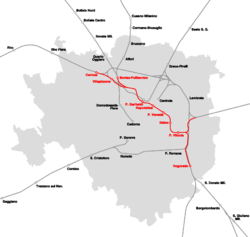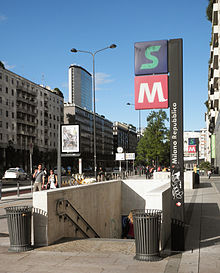- Milan Passerby Railway
-
Passante ferroviario di Milano 
Dates of operation 1997–present Track gauge 4 ft 8 1⁄2 in (1,435 mm) (standard gauge) Electrification 3000 V CC Length 13 Km Website Il Passante Central section Legend




From Turin and Domodossola 




13+316 Milano Certosa 









Ring line 




12+036 Milano Villapizzone opned 2002 









Milan–Saronno line (FN) 




Bovisa branch 




9+734 Milano Lancetti opened 1997 









8+410 Milano Porta Garibaldi opened 1963/97 









"Passantino" to Greco Pirelli and Lambrate 
7+322 Milano Repubblica opened 1997 
6+376 Milano Porta Venezia opened 1997 
5+063 Milano Dateo opened 2002 
3+204 Milano Porta Vittoria opened 2004 





Rogoredo branch 




Ring line (low) 




Ring line (high) 




Ring line (low) 




From Milano Lambrate 




0+000 Lambro junction From Milano Lambrate 




Goods line from Milano Smistamento 




To Venice (DD / LL) Bovisa branch Legend

0+000 Milano Lancetti 
Certosa branch 
Certosa branch 
FN line from Milano Cadorna 
1+911 Milano Bovisa–Politecnico opened 1879 
FN lines to Asso / Saronno Rogoredo branch Legend





3+204 Milano Porta Vittoria 





Pioltello branch 


Ring line 


Southern ring line 





9+567 208+751 Milano Rogoredo 


To Genoa / Bologna The Milan By-pass Railway, (Italian: Passante ferroviario di Milano), is an underground railway which runs through Milan, Italy. "Passante" is the Italian for "passing" and is used to describe a railway built through a major city, connecting suburban lines, modelled on the underground junctions built in West Germany in the 1970s.
The first part of the passante was opened in 1997 and it was completed in 2008.[1] Its main feature is to be open in its extremities, and to be directly interconnected with the railway system of Lombardy. It is only used by suburban trains operated by Trenord.
The passante is connected with subway lines at Porta Garibaldi station (Line 2), Repubblica station (Line 3) and Porta Venezia station (Line 1).
The railway runs on the same line of the ancient Milanese northern railway, which was removed in 1931 when all Milan railway system was redesigned consequently to the opening of the new monumental Central Station.
History
The idea of a suburban railway network for the city of Milan can be traced back to the '60s, when the increasing population of the city and the sorrounding boroughs made clear the need for a faster and more efficient way to move on medium-long range. Final projects for an underground railway passing through the city centre were completed at the end of the 1970s, and construction began on 1982, with the work expected to be completed in less than 10 years.[2]
Actual work procedeed very slowly, taking 15 years just to open the first part of the track from Bovisa to Porta Venezia.[2] From 1997 only a shuttle service was operated on the partially-completed track, until 2004 when a suburban service was activated.[3] The cost at that time was already €915 million after 22 years of construction work.[4]
However, only in 2008 the railway was completed with the opening of the last station, Rogoredo.[3]
References and Notes
- ^ http://www.sottomilano.it/storiapass.htm
- ^ a b http://www.miol.it/stagniweb/sfr01.htm#parte1
- ^ a b http://www.msrmilano.com/passante_ferr.htm
- ^ "Passante, nuovo metrò di Milano". Corriere della Sera. http://archiviostorico.corriere.it/2004/dicembre/12/Passante_nuovo_metro_Milano_co_7_041212002.shtml. Retrieved 3 October 2011.
External links
 Urban rail transport in Milan
Urban rail transport in Milan Milan Metro
Milan Metro Suburban railwayS1 • S2 • S3 • S4 • S5 • S6 • S7 • S8 • S9 • S10 • S11ATM (Azienda Trasporti Milanesi) • Trenord • Milan trams • Railway stations in MilanCategories:
Suburban railwayS1 • S2 • S3 • S4 • S5 • S6 • S7 • S8 • S9 • S10 • S11ATM (Azienda Trasporti Milanesi) • Trenord • Milan trams • Railway stations in MilanCategories:- Transport in Milan
- Railway lines opened in 1997
Wikimedia Foundation. 2010.


